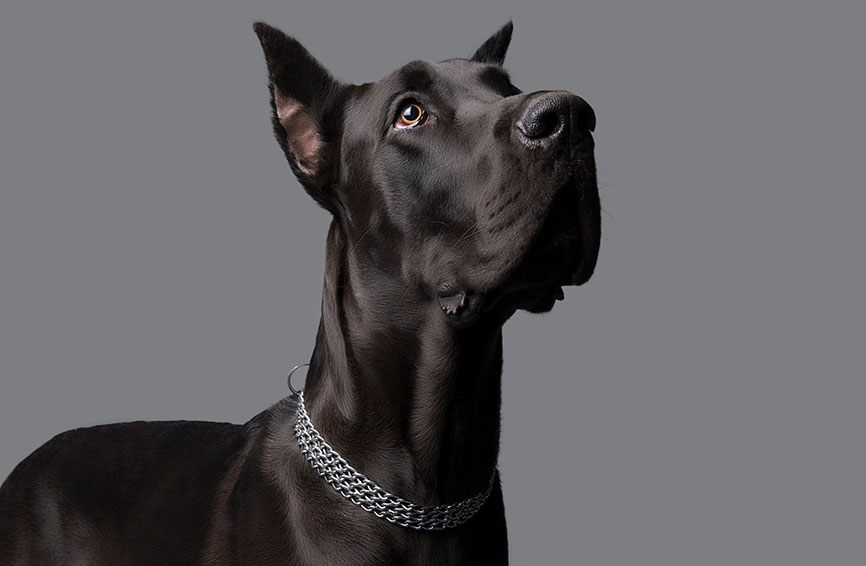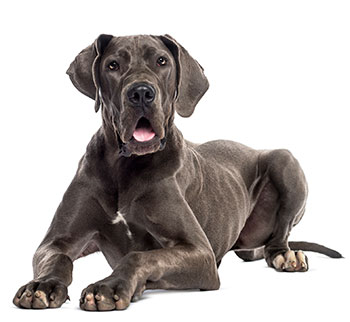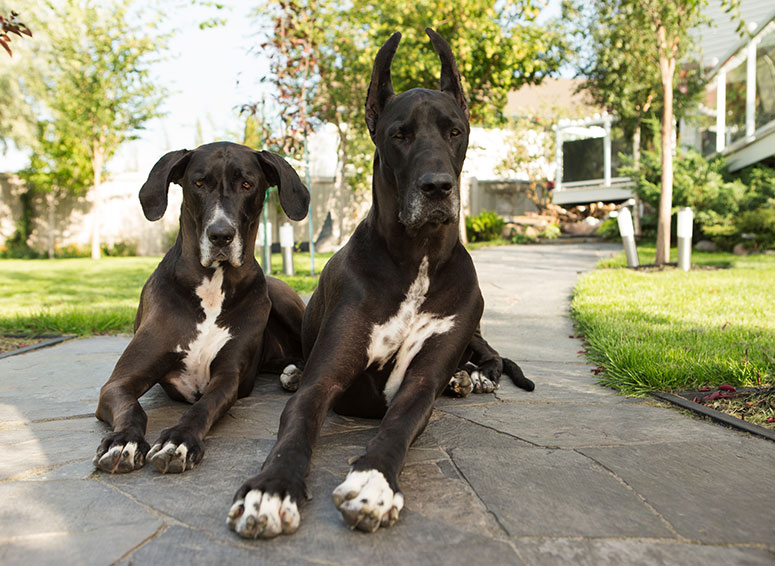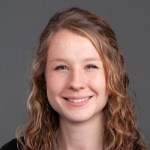Table of Contents
Introduction to Great Danes
Great Danes are among the largest dog breeds in the world, but these massive canines are gentle giants who are also very friendly and dependable. They are classified as working dogs and very easygoing despite their size. As you get to know a Great Dane, you’ll find that they make friends easily, love to please people, and make a great guard dog to deter potential intruders.
Here is some information about the Great Dane to help you determine whether this is the right dog for you.
Size of Great Danes
Probably the most remarkable thing about a Great Dane is its size. Male Great Danes weigh between 140 and 175 pounds and stand 30 to 32 inches tall when they are fully grown. Adult female Great Danes weigh between 110 and 140 pounds and stand 28 to 30 inches tall. A Great Dane will typically reach its full height between 1 to 1.5 years of age.
Here’s how big you can expect your Great Dane to get as he gets older. Male dogs weigh in at the high end of these ranges, while female dogs are generally at the lower end.
| Weight Chart | 3 months | 6 months | 9 months | 12 months |
| Male and Female Great Danes | 30-45 pounds | 70-105 pounds | 85-125 pounds | 90-140 pounds |
Characteristics of Great Danes
Great Danes are powerful, elegant, and beautiful dogs that stand taller than most people when they get up on their hind legs. Great Danes also exhibit alertness, friendliness, and protectiveness. They make great family dogs. With a sleek appearance and formidable bark, these dogs are not overly energetic or destructive. As you might expect, they eat a hearty diet. Due to their size, this breed has a shorter lifespan than most other dog breeds.
Here are the breed characteristics you can expect if you decide to get a Great Dane.
| Breed Characteristic | Level (High, Medium, Low) |
| Affectionate with People | High |
| Good with Kids | High |
| Good with Pets | High |
| Need for Exercise | Medium |
| Energy Level | Medium |
| Intelligence Level | Medium |
| Able to Be Trained | Medium |
| Amount of Barking | Medium |
| Amount of Shedding | Medium |
History of Great Danes
Great Danes are a German dog breed that is also associated with Denmark, hence the name “Dane.” However, it is not clear through historical records exactly why the dogs are connected to Danish culture. This is a well-established breed of dog that has been around for many years. In fact, you’ll find depictions of dogs that look like Great Danes in ancient Egyptian artifacts and Babylonian temples dating back to 3,000 B.C. and 2,000 B.C.
German aristocrats once used Great Danes (known as the Deutsche Dog in Germany) to hunt wild boars. Aside from hunting, these dogs have also been used throughout history to protect homes and people. The Great Dane was one of the earliest breeds to join the American Kennel Club after these dogs were brought over to the U.S.
Great Dane Standard Information
Great Danes are judged at dog shows based on standards that describe the ideal characteristics of this breed. The general appearance of this dog is regal, strong, dignified, smoothly muscled, and well-balanced.
Here is an overview of the breed standard information for Great Danes.
Head:
- Rectangular, long, and expressive head
- Full, square law with deep muzzle
- Medium-size, dark, and deep-set eyes
- High-set, medium, and moderately thick ears
- Black nose, except for blue-black nose in the blue Dane
Neck, Topline, Body:
- Firm, high-set, and well-arched neck
- Broad, deep, and well-muscled chest
- Short, level back with broad loin
Forequarters:
- Strong and muscular forequarters
- Elbow is one-half the distance from withers to ground
- Feet are round and compact
- Dewclaws may or may not be removed
Hindquarters:
- Hocks well let down
- Rear feet round and compact
- Nails are short, strong and dark
Coat:
- Short, thick, and with a smooth and glossy appearance
Color:
- Can be brindle, fawn, blue, black, harlequin, mantle, or merle
Gait:
- Strong and powerful with long and easy strides
- Backline level and parallel to the ground
Caring for Great Danes
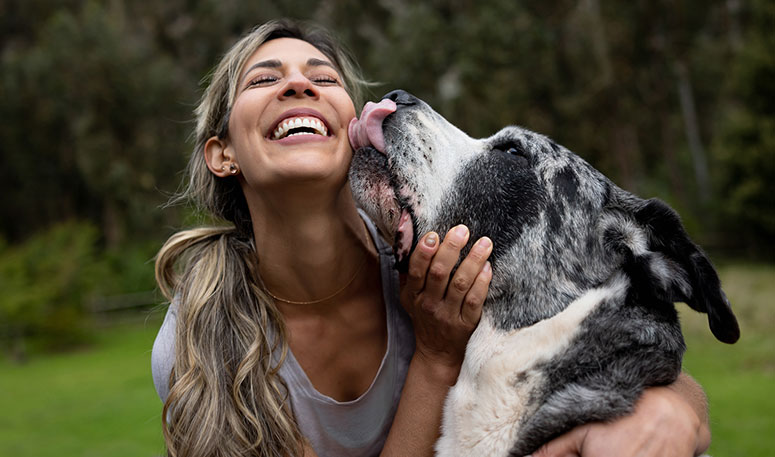
Caring for a Great Dane is a true joy because of the breed’s demeanor and temperament. However, you will need to ensure that your Great Dane is regularly exercised each day. Since Great Danes are prone to bloat, avoid exercising your dog right after mealtimes.
Here are some general tips for taking the best care of a Great Dane.
Best Living Environments:
- Houses with large yards
- Not good for small apartments
- Yards should be fenced for the dog’s safety
- Do not leave the dog alone for long periods of time
Type of Exercise:
- Two or three brisk walks per day
- Hikes with family members
- Jogs with family members after the dog is two years old
- Playtime in a yard
- Between 30 and 90 minutes of exercise per day, depending on the dog’s age
Mental Enrichment:
- Agility training
- Obedience training
- Tracking events
- Flyball and other sports
Training Strategies:
- Start obedience training early for this large breed
- Very easy to please and responds to consistent training
- Give affection and praise during training
- Train to walk well on a leash
- Practice crate training to prevent accidents and messes in the house.
Grooming Tips:
- Short and smooth coat doesn’t shed too much
- Shedding season happens once or twice per year
- Brush weekly with medium-bristle brush
- Bathe regularly
- Trim nails regularly
Common Health Problems of Great Danes
Compared to other dog breeds, Great Danes have shortened lifespans of just seven to ten years. Great Danes are prone to various health issues during all stages of life, which is why it is so important to sign your dog up for pet insurance to help cover costly vet bills.
For example, bloat (officially known as gastric dilatation-volvulus) is very common among Great Danes and can result in death if left untreated. Because this is such a major risk, some Great Dane breeders and pet parents choose to have a dog undergo prophylactic gastropexy surgery to reduce this risk. Great Danes are also prone to cardiac and eye diseases, hip dysplasia, cancer, orthopedic conditions, and hypothyroidism. The Great Dane Club of America recommends that these dogs get the following health tests:
- Hip evaluation
- Cardiac exam
- Thyroid evaluation
- Ophthalmology exam
Diet and Nutrition for Great Danes
Great Danes do best with multiple small meals per day to prevent the distending and twisting of the stomach that may cause bloat. Bloat is the top cause of death among Great Danes so planning and scheduling mealtimes is very important with this breed.
It is important to feed an age-appropriate diet during all life stages (puppy, adult, senior). The recommended amount is based on your dog’s weight and can be found on the dog food label.
Where to Adopt or Purchase Great Danes
The Great Dane Club of America, Inc. is the national breed club for this type of dog and dates back to 1889. You can search for AKC-registered Great Dane puppies on the AKC Marketplace, an online resource for people looking for purebred Great Danes.
However, you will often find Great Danes in animal shelters and rescue groups as well. Examples of rescue groups that focus on Great Danes are the Great Dane Club of America Rescue, Great Dane Rescue, Inc., Great Dane Rescue of North Texas, and Rocky Mountain Great Dane Rescue.
Related Breeds
Pet-lovers who enjoy being around Great Danes may also be interested to learn about these similar dog breeds that share some characteristics with the Great Dane:
- Doberman pinscher
- German pinscher
- Beauceron
- Mastiff
- Saint Bernard
Pet Insurance for Great Danes
Now that you know Great Danes a bit better and understand the issues that can affect their health, you can see why pet health insurance is so necessary for this dog breed. Healthy Paws pet insurance covers new accidents, illnesses, cancer, emergency care, hereditary conditions, alternative care, and more.
Request your Great Dane pet insurance quote on our website today to start planning for your pet’s future.
